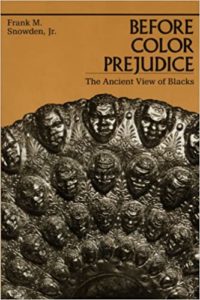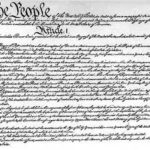Let’s Talk About Race and Racism. Part 2: Antiquity and Medieval Times
This series of post has the purpose of telling the truth about race and racism, as best I’m able. What I have to say in the end will neither particularly agree with either Conservatives or Liberals on this topic. My perspective is based on history and I am in fact suprised that history isn’t studied more–or understood better–on this topic.
I mentioned in the last post that ethnocentrism is seen reflected in the Bible in a number of ways–and when talking about Israel, is even justified in a way, even though the teachings of Jesus and the apostles worked to remove ethnic distinctions. Still, even though they encouraged friendliness to all (love your neighbor as your self, love your enemies), they did set distinctions between those inside the community of faith and those outside it (again . I Cor 5:11-12). The apostles also used language that compared Christian believers to a nation or ethnic group, even though we really are not (e.g. I Peter 2:9). So you could call the preference we are supposed to have a type of “ethnocentrism”–though technically no “ethno” or nation is involved, just a “-centrism.”
Racism is not delineated as a specific sin in the Bible for the simple reason that just as smoking cigars or cigarettes was unkown in the ancient Old World (though they did burn incence), racism as we know it was unkown in Bible times. People might have preferred their own group over others, but they had no concept of a set of races and a heirarchy among those races.
So where did racism come from? Was it from Classical Greece and Rome?
Certainly we know modern racism arose from Western culture. But what aspect of Western thought caused it?
Did it come from those philosophical Greeks? Or law-crafting and militaristic Romans? Or was it a product of the Middle Ages?
This post tackles the previous three questions and answers them NO, NO, and No, well, mostly no.
My primary source for the answer regarding Greek and Roman thought comes from Frank M. Snowden Jr, a renowned Classics scholar who extensively studied this issue. I believe his perspective on this topic reflects the academic consensus, even today, so it does surprise me what he had to say about this isn’t as widely known as it should be. (Dr. Snowden was, by the way, black.)
Snowden wrote quite a lot on this topic but circa 1992 I discovered his book Before Color Prejudice, The Ancient View of Blacks. He looked in depth at Greek and Roman sources and found quite conclusively (something I’ve also seen reflected elsewhere in classical primary sources) that the concept we know of races today was unkown to them. Yes, they showed signs of ethnocentrism, but not racism.

The cover of Snowden’s book.
The term “barbarian” was applied by the ancient Greeks to “one who does not speak my language.” The use for the Romans for this term was at first “one not Roman” but eventually was applied to those outside the Roman empire. So when the Greeks and Romans looked north and south, what did they see? Did they see Europe north of the Mediterranean as inhabited by the same race as them, while Africans were another race? No.
Both the tall blond barbarians of the north and the tall dark-skinned barbarians of the south they saw as equally different from themselves. Yes, they saw themselves as superior to both groups in various ways (ethnocentrism) and they did recognize that Africans were different from themselves. But they also saw Germanic and Celtic peoples as different from themselves. And at times they directly compared Africans to Northern Europeans and saw them as having more in common with each other than with their people. Because black Africans and northern barbarians were in the Greek/Roman view less civilized, taller, physically stronger (though not as capable of working long hours in Roman prejudice), with larger bust size among their women. Whereas they saw their people as having a reasonable height and physical form and a moderate skin color.
So the concept of white as we know it that includes all Europeans didn’t even actually exist for the ancient Greeks and Romans. They saw themselves as distinct (and yes, better) than peoples from both their far north and their far south. No racial prejudice existed among them. None. Ethnocentrism, yes existed, but racism did not exist.
A Hopeful Note
I plan to build on that idea as these posts continue, but isn’t it a hopeful note to realize that since a society has already existed without racism, that means it is false that racism must always exist? Oh, definitely now that it’s around it won’t be easy to eradicate. But the notion that racism is natural to human beings, that it has always existed–that notion is false. History shows it to be false.
Which also means that “inherent bias” doesn’t have to be a thing. If there was a period in history when it did not exist, it does not have to exist now.

Ancient Roman art (public domain) portraying a citizen from Africa. Taken from Africasource.com
A Few Words on Afrocentrism
Also in the 90s I became aware of a means of interpreting world history called “Afrocentrism.” While this–uh, let’s call it a “movement” is widely discredited by many historians, it’s worth mentioning here. Because Afrocentrists in effect maintain Europe was always racist–that the supposed great thinkers of Greece and the achievments of Roman were plagiarized from African civilizations, especially but not exclusively Egypt (Egypt is seen as an exclusively black civilization as well–but it was actually mixed race and mostly not black, though some dynasties of pharaohs were black). Afrocentrism as I understand the term sees Europe as always exploiting Africa.
Frank M. Snowden Jr. didn’t see things that way–he read his sources and found the data in writings of Greeks and Romans and did not believe in effect they were engaged in a giant conspiracy to cover up how they really felt. He saw that Europeans did not in fact hate Africans or rob everything they had from them.
The important thing to note for this post is only an extreme view like Afrocentrism disagrees with the view that Greeks and Romans did not have any racism as we know it. Otherwise, everyone agrees on this subject. But far too people have heard it.
Medieval Racists?
So if racism comes from Western culture (it does, we’ll get to explaining how in a future post) but does not come from the Greco-Roman ancestors of Western culture, where did it come from?
Was it from medieval thought and philosophy? That pesky Catholic church of the Middle Ages?
No. Well, mostly no. A few antecedents were around.
One cultural aspect of medieval thought was a general association with the color white as good and the color black as bad. I don’t have the time for a deep dive into this aspect of the human psyche, but it isn’t limited to Europeans. Humans generally are more afraid of the dark than they are the light–becasue we are so dependent on sight that losing the ability to see at night poses real dangers for us. And we associate glowing light with holiness or magical power–and not just Europeans have that association. If you examine Ethiopian Orthodox icons, for example, you will see a glow portrayed behind the heads of saintly people, just like other icons from other Orthodox nations.
Zoroastrianism from Ancient Persia has the ultimate association of light and dark with good and evil. And of course, their ideas didn’t come from Europe.
Note though the white/black association of good and evil was not entirely universal. In Russia, white was the traditional color of mourning and thus carried an association with death. Since medieval armor was usually shiny and “white” but sometimes was blued as gunsteel is, some medieval armor was black or black-ish. And the archetypical “black knight” in European thought did not really mean “evil knight.” Rather the association of being a “black knight” was often being mysterious. Maybe especially powerful. But not necessarily evil.
In the same vein, the English prince Edward, who ruled part of France in the 1300s was known as “the Black Prince.” And the use of “black” was not really negative in his case. And it definitely wasn’t racial.
During the Crusades we see a bit of association begin to creep into Europe that being darker skinned was a sign of being an infidel–since the Arabs the Crusaders fought against were on average of a darker complexion than they were. But this didn’t amount to any full-blown racial theory. Really it was more of a preference for their own kind–ethnocentrism–with a religious aspect to it.
More significantly in my opinion was a tendency in Medieval thought to look at the three sons of Noah as belonging to the three continents. Ham was seen as the father of all Africans, Shem all Asians, and Japheth all Europeans. In effect adapting what the Bible says to their knowledge of the three continents they knew of…except Europe and Asia are not really geographically distinct. And numerous places in both Europe and Asia the Bible says hosted decendants of Ham…plus places the Bible clearly shows mixes of decendants of Noah…but these nuances were lost on European Christians of the Middle Ages.
Class Differences in Color
There’s another aspect worth mentioning here. Most Europeans were peasants and worked long hours raising crops in the sunshine. Most Europeans had deeply tanned and sun-damaged faces and arms. However, the nobility had the priviledge of spending a great deal more time indoors. And noble women were scarcely required to go outside at all.
So someone with an actually pale face was a rarity in Medieval Europe. And this was prized as a rarity–we see quite a lot of European references to “fair women,” the word itself associating being light-colored with being beautiful. This isn’t too hard to understand.
This association of deep tanning to poverty and paler skin to nobility isn’t limited to Europe. China as I understand it had similar prejudices and I would actually expect most East Asians felt the same way. The upper castes of India are generally lighter-skinned than the lower castes–certainly an association of class and color exists there. Even the Bible in one passage reflects this class association with color (Song of Solomon 1:5, sometimes translated as “black but beautiful,” though clearly a reference to tanning), showing that West Asians also thought along these lines.
But note that an association of people of lighter skin in your own culture with them being nobility is not racism. It actually reflects a reality of who is and who is not the poor people out working in fields. Though of course preference for nobility is itself a kind of prejudice and one unworthy of Christians from what I see in the Bible. But it is not actual racism when we look at the historic past.
Conclusion
I would say that even though Greco-Roman thought was free from racism and medieval thought mostly was not racist, some aspects of medieval thought set the stage for the era of racism that would begin with the European “Age of Exploration.” I find the division of the world into sons of Shem, Ham, and Japheth especially significant. But other aspects of medieval thought were important as well. We’ll talk more about that next time.
Note that even thought this post isn’t specifically about fandom or speculative fiction, a lot of fantasy fiction portrays medieval times or eras that parallel medieval times. So the aspects of ancient and medieval culture that relates to racism in reality clearly relates to ficitonal portrayals of societies as well…
Readers, what are your thoughts on this topic so far? Did you already know about ancient Greece and Rome in relation to race? About Medieval Europe? Afrocentrism? Please let us know in the comments.









































Interesting article—thank you! My understanding is that racism as we know it started after the discovery of the New World. As unscrupulous Europeans figured out the amount of money they could make in the tropics with cash crops like sugar, and that they could use slave labor to further increase their profits, they started to create “justifications” for why this new brutal form of slavery was okay to perform against certain populations. I’ll be interested to see if your research backs this up, or if there’s something more I’m missing.
It would be a complicated thing to fish through, the distinction between race and class even in Renaissance Europe. Slavery was a thing in Bronze/Iron Age Europe, but it seems to have mostly manifested as serfdom, with the ownership and wealth tied to (land) inheritance rather than as a separate commodity. But the serf population got more legal rights (especially after the plague, when they got leverage for better treatment from the decimated work population), so by the time of the Renaissance, it was pretty much illegal to practice slavery on “white” European populations. Indentured servitude, yes, but even they had some legal protections.
So if the Europeans wanted to practice legal chattel slavery, they WOULD have had to import from other races. The Ottoman empire still practiced slavery, and IIRC the Europeans took a lot of pages from their book. Arguably, it got worse the more driven by capitalism it got, when it got into terms of pure profit rather than simple survival. The southern American colonies, especially, were driven by profit rather than the small-farmer survival-driven culture in the north. Heck, Georgia was trying to set itself up as a state of free small-holders (white trash thrown out in the wilderness to sink or swim) until people like George Whitefield (yes, THAT George Whitefield) f**ked it up by using money and influence to loosen slavery laws so they could develop the for-profit plantations like Virginia had.
And that, children, along with Southern Baptists, is why you should take the progressive history of the evangelical types with a few grains of salt. George f**kin Whitefield.
Yes, the old forms of slavery in the ancient/medieval world weren’t a picnic by any means. But the new, dehumanizing chattel slavery was a whole new level of abuse, and required a lot of racist “justification” and a lot of people back home turning a blind eye. The colonization of the New World (especially the Caribbean and what would become the US) was inexorably tied into the plantation/slavery model.
It’s distressing how many people who should have followed the clear New Testament ethics regarding love and service for others were so easily corrupted by the allure of money and creature comforts (sugar, for example, which in that time depended completely on slave labor) that they bought into these racist, anti-biblical ideas wholesale. We’re still dealing with the fallout of these moral failures.
Yeah, I know quite a lot about George Whitefiled. Never heard that English revival preacher did anything to make slavery easier. And why would he? He was English.
So you’ve gotta show a source on this one.
As for the rest of your take on history, I agree with a bit of it but mostly disagree. But I’m going to tread that ground in future posts.
So if you can show a source for your assertion on Whitefield, please do.
IIRC, it was the book “White Trash: The 400-Year Untold History of Class in America” by Nancy Isenberg.
I think it would make a nice addition to any reading on this subject, to put some nuance in the muddled issues of class and race.
I don’t think the ethnocentrism is as distinct from the racism as you’re kinda implying. One easily bleeds into the other. It makes a depressing kind of sense that as the Europeans explored (and exploited) farther and farther, they discovered that the foreigners nearer to them were less horrifyingly weird than the foreigners farther away.
Ethoncentrism fed into racism, but they are very different when we get around to talking about white supremacy. Which we’ll get to.
It’s probably just that you’re using the terms slightly differently than how I would.
I’d use “tribalism” to describe the instinctive in-group/out-group thing humans have going on, which you seem to use for “ethnocentrism.” “Ethnocentrism” I would use more along the line of “nationalism.”
IIRC, you were going to make a case for tribalism/ethnocentrism to be a good thing, but I dunno if I’d go so far to call it a “good” thing. I’d consider it more of a neutral phenomenon, since bad things can come from it as easily as good things.
But ethnocentrism can happen across nation lines.
I’m not using them as synonyms, silly beans. I’m trying to capture a sense of scale into the language.
Like, “tribalism” is Viking fans and “ethnocentrism” is American football fans in the aggregate, as opposed to baseball fans or something.
But tribalism can be political groups, which can be massive. It’s not so much scale as it is focus. Ethnocentricsm is surrounding a culture, people from a similar background. Tribalism is people who gather together because of similar interests or goals. At least, that’s my understanding of the definitions.
For the record, if you’re going to call me something degrading, I much prefer silly beans over all the previous ones lol.
Okay then, what term would you use for small, community type groups? Villageism? (I object to that on aesthetics grounds) “Clannishness” has more familial connotations.
Depends on what ties them together… isn’t it obvious? Both could apply, depending on the ties.
Excellent content.
Interesting! I’ve done a lot of research on the Early Middle Ages in England for my historical fantasy series set in the 7th century, and I haven’t seen racism in the Early Medieval Church. In fact, I will refer you to this fascinating article about an African Abbot in 8th century England who was revered for his knowledge, skill in teaching, and character.
https://blogs.bl.uk/digitisedmanuscripts/2016/10/an-african-abbot-in-anglo-saxon-england.html
Yes, I agree. Racism didn’t really exist in the Middle Ages at all…though by the end of the Medieval Period we see some hints in that direction related to the Crusades and a few other bits. But overall, racism wasn’t a thing in the Middle Ages…again, I agree.
Woke/Cancel Culture actually talks about the class associations with color as a part of Colorism. From what I’ve seen, they know about those class associations and really just see it as a nasty part of racism and are less likely to treat it as a separate issue. Or they treat it as a separate issue, but tend to assume that racism is what will make a modern person exhibit colorism(due to cultural things that developed from slavery in U.S. history.) They’ll also point to modern beauty standards. Since they feel like the beauty standards are to be pale, and white people are able to obtain that standard easier, it causes a lot of problems for people with naturally dark complexions.
I can see where they’re coming from, since a person shouldn’t be called ugly just because of their skin tone. But in Cancel Culturey circles, they would probably just take the class associations with skin tone as an indication that racism is disgustingly and irredeemably pervasive. With them, something is more likely to be classified as racist just because it harms POC, even if the problem actually has/is accompanied by other causes. Of course Colorism CAN be an issue, but some people don’t seem to respond to it as well as they could.
And then some of them might take literary devices like dark vs light symbolism and say such things should never exist in literature(even if the story obviously isn’t associating it with race) because it was a precursor to racist thinking, influenced society for the worst, and has a chance of perpetuating racist thinking now.
I dunno. I agree with you on a lot of things, I’m just reflecting on how many people probably know a lot of the stuff you mention, but use it in a destructive way. There’s facts, and then there’s the perception and usage of those facts. A lot of what’s been getting me lately is the way people think they have to react to the information they find… Though I didn’t talk much about the destructive responses themselves.
As a sidenote, there are other significances/symbolism to paler things as well. White animals, for example, tend to stand out in most environments. That tends to be a downside for them, since that makes it harder for them to catch prey/evade predators. Humans often deride unusual things that stand out, but there are plenty of other times when we will be fascinated by those unusual things instead. A king, for example, could want a pale horse because it stands out from the crowd and can command more attention. And many colors had significance based on how easy they were to obtain within a society.
I’m going to eventually treat modern Critical Race Theory and the cancel culture that comes with it as a type of anachronism (well, in part). They read into the past the existence of things that come from the present. So yes, they see class divisions based on how much sun exposure someone got as racist…except racism actually is something else.
I hope to make it clear what racism is and where it came from, and what that means looking at the past, the present, and the future. This will necessitate some direct conflict with many modern ways of thinking. But it will take a bit to develop the entire argument.
In the meantime, you pointing out what certain modern people think about the past is a legitimate thing to point out. They are wrong, but I believe that you’re correctly reporting what they think.
Looking forward to it, Travis!
A few years ago, I did a lot of historical research when writing a history fiction novel about Saint Augustine called The Jagged Road to Sainthood. I can agree with you that the modern view of racism did not exist back then.
Romans looked down on all outsiders but didn’t focus on skin color. Saint Augustine was actually from North Africa and was of the Berbers race. Until I begin doing the research, I didn’t even know there was and still is a race called Berbers.
Augustine spent his youth and early career in Carthage, North Africa, the second largest city in the ancient world. Because of the city’s key location, it consisted of people from many backgrounds from across the known world. One of Augustine’s closest friends was a former slave whose dad owned a villa, and this friend was well educated. Augustine’s concubine for many years was also a former slave. She was uneducated, and it was illegal for her to marriage Augustine because former slaves where not allowed to marry into the senatorial class.
Freemen could own homes and businesses, but could not become full citizens. Their children, though, could buy citizenship and enjoy all the privileges that came with that. So in large cities of the Empire, it was common to see people of any shade mingling with each other. The real divider between the classes was money and education.